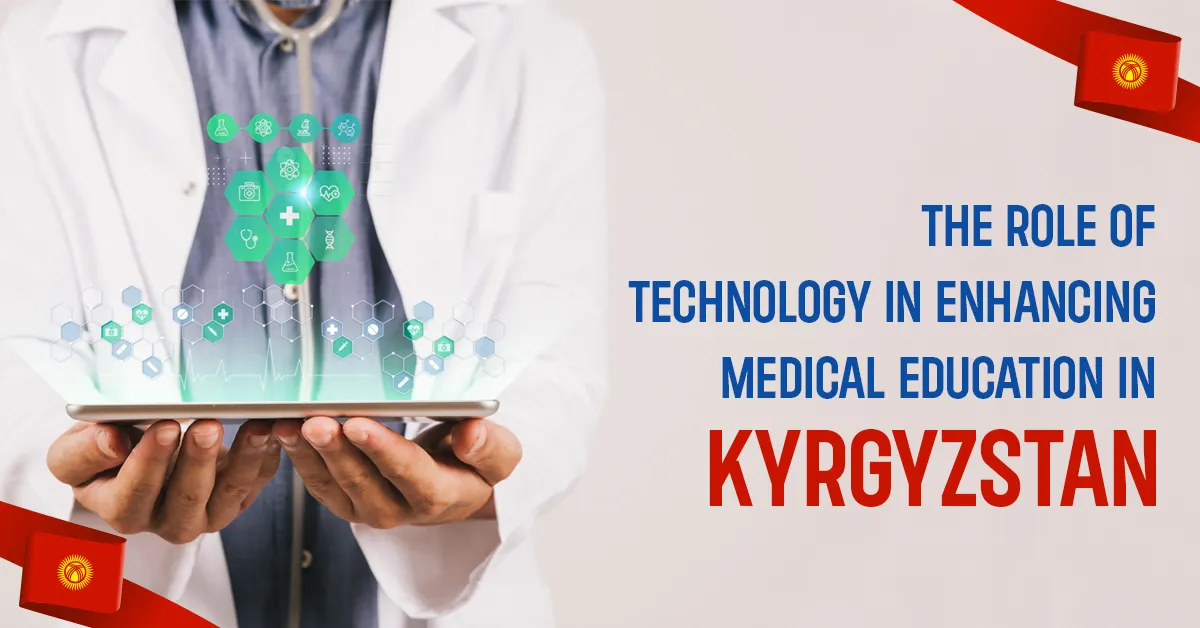Medical education is rapidly transforming and evolving with the advancement in technology, bringing substantial changes in the student's learning progress and preparing them for their medical career. This change is influenced by various factors including the change in the healthcare environment and altered societal expectations. The change in the healthcare environment significantly impacts the medical education system. It is driven by various factors such as the advancement in technology, increasing costs of healthcare facilities, changes in the expectations of the patients and public in general, and more.
Technology has played a vital role in enhancing medical education in Kyrgyzstan, bringing about significant improvements in the training of medical professionals and the overall healthcare system. As one of the Central Asian countries, Kyrgyzstan has faced challenges in providing quality medical education and access to modern healthcare facilities in the past. However, with the integration of technology into medical education, Kyrgyzstan has witnessed positive changes and advancements in several key areas
Change in Medical Education in Kyrgyzstan due to Technology
Technology has become part of every human's life. Over the years, technology has impacted medical education, revolutionizing the way medical professionals are trained and improving the overall quality of healthcare. From virtual simulations and online resources to advanced medical devices and communication tools, the integration of technology has brought about numerous changes in medical education. Here are some key ways in which medical education has evolved due to technology:
Access to Up-to-Date Medical Information
Technology has enabled medical students and educators in Kyrgyzstan to access the latest medical research, textbooks, and resources from around the world. Online platforms, digital libraries, and medical databases have opened up a wealth of information that was previously difficult to obtain. This has empowered students and faculty with the most current knowledge and practices in medicine.
Virtual Simulations and Training
Traditional medical education heavily relied on real patients for hands-on training, which posed ethical and safety concerns. With the advent of technology for MBBS in Kyrgyzstan, virtual simulations and advanced patient simulators have become valuable tools for medical students studying MBBS in Kyrgyzstan to practice procedures, diagnose diseases, and refine their skills in a risk-free environment. Simulations offer a safe space for medical students to make mistakes, learn from them, and gain confidence before dealing with real patients.
Online Learning Platforms
The internet has opened up vast opportunities for medical education to be delivered online. There are now numerous e-learning platforms offering courses, lectures, and resources that cover various medical topics that helps the medical students gain more knowledge for their MBBS in Kyrgyzstan. Medical students and professionals can access lectures from renowned experts, participate in interactive discussions, and access a wide range of study materials at their convenience. Online learning has made medical education more accessible to learners worldwide.
Mobile Applications
Mobile apps have transformed medical education, offering a range of tools and resources right at the fingertips of medical professionals. From medical dictionaries and drug reference guides to anatomy apps and clinical decision support tools, these applications provide quick access to essential information, making it easier for medical students and practitioners to stay updated and make informed decisions.
Medical Imaging and Diagnostic Tools
Technology has led to significant advancements in medical imaging and diagnostic tools. High-resolution imaging technologies, such as MRI, CT scans, and ultrasound, have become indispensable in medical education, enabling MBBS students in Kyrgyzstan to better understand anatomy and pathology. Moreover, these advancements have helped medical students in enhancing their knowledge, improved the accuracy and early detection of diseases, and enhancing patient care.
Telemedicine and Telehealth
Telemedicine has been enabling remote consultations and virtual patient interactions. Medical students can now observe and participate in virtual rounds and consultations, breaking the barriers of distance. This exposure broadens their understanding of healthcare delivery and prepares them for modern healthcare challenges.
Collaborative Learning Tools
Technology has facilitated collaborative learning, allowing medical students and professionals from different parts of the world to interact, share experiences, and work together on research projects. Virtual conferences, webinars, and online forums promote global collaboration and exchange of knowledge between the students studying MBBS in Kyrgyzstan and other countries.
Wearable Health Devices
Wearable health devices, such as fitness trackers and smartwatches, have started to be integrated into medical education. These devices can be used to monitor patient health and collect real-time data, providing medical students with valuable insights into patient management and population health.
Technology Assisted Medical Education
In today's generation, with the advanced in Technology, there are many technologies that are being used in providing education to medical students at the Top Medical Universties in Kyrgyzstan.
One of the primary advantages of technology-assisted medical education in Kyrgyzstan is the accessibility it provides to learners. Online platforms, webinars, and virtual classrooms have enabled medical students, doctors, nurses, and other healthcare professionals from diverse geographical locations to access high-quality education and training. This accessibility breaks down barriers and allows individuals in remote or underserved areas to receive top-notch medical education, thus contributing to bridging the healthcare disparities gap.
Computer-based learning, simulation learning, virtual reality and other form of advanced technological learning have long been used for educational development at the Top Medical Universities in Kyrgyzstan.
Wrapping Up
By embracing technology in medical education, Kyrgyzstan has taken significant strides toward improving the competence and skills of its medical workforce. These advancements have not only benefited medical students and educators but also had a positive impact on the overall healthcare system, leading to better patient outcomes and improved healthcare services throughout the country. Continued efforts to integrate technology in medical education will undoubtedly contribute to further progress and development in the healthcare sector in Kyrgyzstan.
➠Also Read: MBBS in Kyrgyzstan for Indian students, in a nutshell


Advantages and Disadvantages of Studying MBBS in Kyrgyzstan
The Road to Medical Success: Exploring Job Opportunities for MBBS Graduates from Kyrgyzstan
The Role of Technology in Enhancing Medical Education in Kyrgyzstan